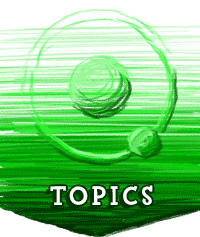| Octahedral Crystal |
This is a crystal that has eight sides. Think of a shape with two pyramids attached at their bases.
More Information: Solids |
| Orbit |
An orbit is the path one object takes when it spins around another object. An electron has a path in a circle around the center of the atom. The Earth has an orbit around the sun. Since electrons can move in any direction around the center of the atom, their space is called a shell.
More Information: Atomic Structure |
| Orbital |
The orbital is where an atom keeps its electrons. An atom can have up to seven orbitals. We also call it a shell.
More Information: Atomic Structure |
| Orthorhombic Crystal |
This crystal forms a prism that has three edges at ninety-degree angles.
More Information: Solids |
| Osmium |
Symbol:"Os" Atomic Number:"76" Atomic Mass: 190.20amu. This element is one of the transition elements. Osmium is found in nature with platinum and nickel. It actually has the highest melting point of the group and is used in alloys that require a lot of strength.
More Information: Transition Metals |
| Osmosis |
This process happens when water molecules move from an area of high concentration to low concentration. They need to pass through a semi-permeable membrane. It often happens when larger molecules are not able to cross the membrane and concentrations need to be evened out.
More Information: Solutions |
| Oxidation |
This is when an atom loses one or more electrons. Scientists may also use the term when describing ions or molecules.
More Information: Ions |
| Oxide Mineral |
A mineral that is made up of compounds with an oxygen atom bonded to a metal. A ruby is a good example of an oxide mineral.
More Information: Oxygen |
| Oxidizer |
An oxidizer can also be called an oxidizing agent. It is something that can oxidize another substance. Some major oxidizing elements are chlorine and oxygen.
More Information: Chlorine |
| Oxygen |
Symbol:"O" Atomic Number:"8" Atomic Mass: 16.00amu. Oxygen is a gas and is classified as a non-metal. It is found in the crust of the Earth and in the air. Animals need oxygen to survive. It is also very reactive. You will also find it in ozone and plastics.
More Information: Oxygen |



